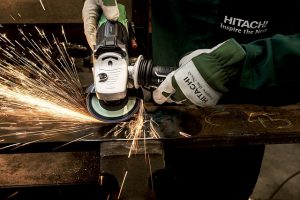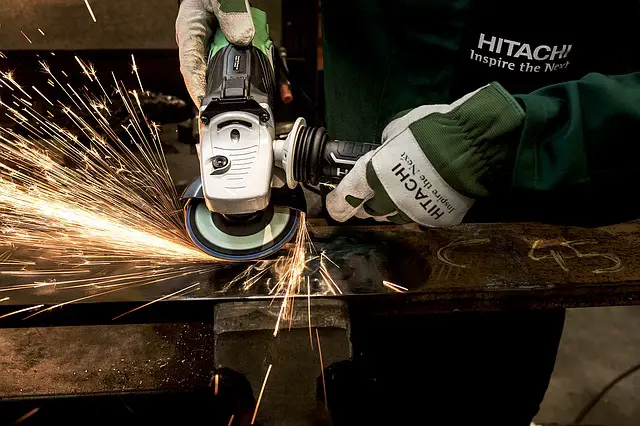Welcome to our article about the differences between grinders and sanders!
Below we’ll go through all the features, pros and cons of these two tools, but first a quick summary.
Contents
Grinders vs Sanders – Quick Summary
We go through a lot of information below, so first here’s a quick summary of the difference between grinders and sanders.
Grinders are a highly versatile tool that can be used for grinding, cutting, stripping and polishing a wide variety of materials. Sanders are less robust and are typically limited to sanding and polishing wooden surfaces.
Ok, now let’s get into the full article!
Grinders vs Sanders – Introduction

Grinders and sanders are two of the most common power tools that come to mind when working with different surfaces and materials.
Their many similarities generally cause them to seem interchangeable with one another, sometimes blurring the line between them in terms of functionality as well as application.
They are, however, two very different tools, and each one may be suited to a particular task over the other. Deciding which one to use be a bit complicated, especially for beginner handymen and DIY buffs.
If you are wondering whether a grinder or a sander is right for you, keep reading as we discuss the similarities and differences between grinders and sanders.
At the end of this article, you should be able determine which tool is right for your next project (and every project after that, too!)
What is a Grinder?
A grinder is a power tool that is mainly used for grinding, cutting, brushing, and sanding.
It’s ultimate purpose is to remove material from an object through friction or other abrasive means.

The two most common types of grinders are belt grinders and angle or side grinders.
Belt grinders are more often fixed to the ground as a unit than hand-held. They are equipped with an abrasive belt, with some models offering an attachment for a contact wheel. They are usually used by professionals in manufacturing warehouses and can be quite expensive.
Angle or side grinders are tools with a geared head on the side where you can attach abrasives, cutting discs, brushes, and other attachments. These are usually hand-held and are much more beginner friendly and easier to operate.
Grinders are well-suited for cutting, shaping, removing old paint from metal surfaces, and polishing a wide variety of surfaces.
They can be used on wood, metal, stone, plastic, and even concrete.
What is a Sander?

A sander is a power tool mainly used to smooth and polish surfaces using sandpaper as the abrasive medium.
Most sanders are hand-held tools, although there are stationary ones as well.
The two most common types of sanders are belt sanders and disc sanders.
Belt sanders are equipped with a sandpaper belt which rotates around an axis, and are most commonly used for sanding large areas such as wooden floors, decks or slats.
Disc sanders are typically stationary tools equipped with a sandpaper disc instead of a belt, where the disc rotates in a fixed circular motion around an axis.
An orbital sander is a type of disc sander that is usually smaller and hand-held.
The sandpaper in an orbital sander rotates in a similar way, but may also have a back and forth motion incorporated (this is known as a random orbital sander).

Sanders are well-suited for shaping small or detailed areas, sanding surfaces, removing old paint from wooden surfaces, smoothening and rounding edges of wooden boards, and polishing.
Probably the most prevalent application of sanders is on wood and plastic, although there are now more powerful and specialized sanders that will enable you to work on tougher materials such as stone, marble, metal, and concrete.
Difference between Grinders and Sanders
The uses and applications of grinders and sanders, as was mentioned before, can overlap a bit, but they are essentially two different tools.
Below we discuss several points of comparison that can distinguish one from the other:
Attachments
One of the most basic differences between a grinder and a sander is the type of attachments that each of these tools uses.
Grinders can be used with a wide variety of attachments that are each designed for a specific purpose.
A grinder can be used with a diamond tuckpointing wheel, grinding wheel, dry-cut diamond wheel, metal cut off wheel, wire cup brush, or wire wheel.
Sanders use sandpaper belts or pads which are held in place with Velcro or clips. The only variety with the sandpaper belts and pads is the range of different grits, which offer more or less abrasion when used.
Materials
Grinders can be used not only on wood, but also on metal, stone, plastic, and concrete.
Sanders are typically limited to use on different types of wooden surfaces only.
Versatility
Grinders can be used to strip metal or other surfaces of paint. They can be used to cut metal pipes, bolts, rods, or other hard materials. You can even buy sanding discs for grinders so that you can use them for sanding and polishing.
Sanders, on the other hand, can really only be used for evening and polishing softer surfaces such as wood. They typically can’t be used to cut objects.
Precision
Sanders are typically preferred for precision over grinders. They tend to be seen as gentler tools that are appropriate for more delicate jobs.
Which Should You Choose?
One of the most distinct advantages of a grinder is its versatility.
A grinder is more likely the go-to tool for cutting materials such as planks of wood, bricks or concrete, and for the shaping of furniture and stone objects.
You can even use it to sharpen your knives, blades, and other tools. You could even go as far as sanding, smoothing or polishing surfaces with a grinder if you have the right sandpaper on hand.
A grinder is typically faster and more powerful than a sander, making it suitable for use on hard materials.
A grinder is also equipped to handle a wide array of attachments, and with the right attachments such as large discs, you can finish jobs much faster and cover more surfaces than if you were using a sander.
What’s more, changing the attachments is easy and straightforward.
You can even find grinders equipped with a switch-angle function or slack belt that will allow you to work on surfaces other than flat ones and be able to turn out complex workpieces.
One thing that sets back a grinder, however, is it is not designed to handle plastic or aluminum very well.
Grinding wheels also tend to break easily, especially if not maintained properly.
With a grinder’s high power, this scenario could be quite risky if the user has limited experience.
A sander is mainly suitable for shaping, smoothing, and polishing softer materials. It’s even possible to achieve a shiny finish on some materials when using a very fine sandpaper.
Its obvious advantage is that a sander is usually a hand-held tool that can be quite simple to manoeuver and transport anywhere.
Changing the sandpaper whenever you need to is also quite simple and straightforward.
A sander is usually more suitable for refinishing and refining wood and restoration works, as opposed to cutting and re-shaping material like a grinder does.
A sander is typically less versatile than a grinder. Using a sander can also require a bit of practice as you can easily damage the material you are working on instead of smoothing it.
Sandpaper belts also tend to rip easily if not used with proper care.
Grinders Vs Sanders – Conclusion
Overall, choosing between a grinder and a sander depends completely on the kind of projects that you typically work on.
There are certain instances when either tool would do the job.
However, for the majority of projects:
- If you need power and versatility, a grinder would be perfect for you.
- If you do a lot of woodworking or smoothing different surfaces, a sander is the right choice.
You just need to make sure that whatever tool you buy will meet the needs of your current and future projects – whatever they may be!
We hope you’ve found this comparison article between grinders and sanders helpful. Here are some related articles you may also enjoy:
Ultimate Guide to Nail Gun Types and Sizes
Best Siding Nailers
Best Nail Guns for Crown Molding

About The Author: Hi There! I’m Dave. I’m a certified millworker and carpenter, and have been working in the industry for over 10 years. I created this website to pass on my knowledge so that other enthusiasts, no matter what their skill level, can enjoy the craft as much as I do. I hope you enjoy!

